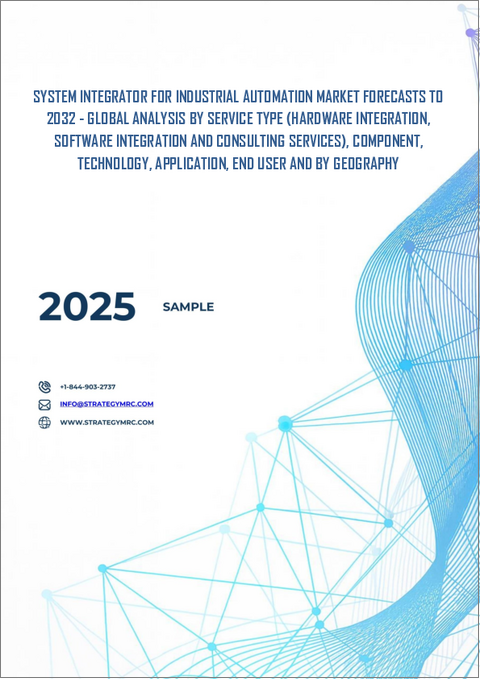|
|
市場調査レポート
商品コード
1744588
産業オートメーション向けシステムインテグレーター市場の2032年までの予測: サービスタイプ、コンポーネント、技術、用途、エンドユーザー、地域別の世界分析System Integrator For Industrial Automation Market Forecasts to 2032 - Global Analysis By Service Type (Hardware Integration, Software Integration and Consulting Services), Component, Technology, Application, End User and By Geography |
||||||
カスタマイズ可能
|
|||||||
| 産業オートメーション向けシステムインテグレーター市場の2032年までの予測: サービスタイプ、コンポーネント、技術、用途、エンドユーザー、地域別の世界分析 |
|
出版日: 2025年06月06日
発行: Stratistics Market Research Consulting
ページ情報: 英文 200+ Pages
納期: 2~3営業日
|
全表示
- 概要
- 図表
- 目次
Stratistics MRCによると、産業オートメーション向けシステムインテグレーターの世界市場は、2025年に248億米ドルを占め、予測期間中のCAGRは5.4%で成長し、2032年には360億1,000万米ドルに達すると予想されています。
産業オートメーション向けシステムインテグレーターは、製造業や産業施設全体のオートメーションシステムの設計、実装、管理を行う専門サービスプロバイダーです。PLC、SCADA、センサー、ロボットなど、ハードウェアとソフトウェアのコンポーネントを統合し、オペレーションの合理化、効率の向上、リアルタイムの制御とデータ分析を実現します。これらのインテグレーターは、オートメーション・ソリューションをビジネス目標に整合させ、互換性と拡張性を確保しながら、運用コストとダウンタイムを削減します。
スマート工場とデジタル化の成長
スマート工場の急速な普及は、IoTやAIなどの先進技術を活用して効率を高めることで、産業プロセスを変革しています。デジタル化によってリアルタイムのデータ収集と分析が可能になり、生産ワークフローが最適化されます。製造業の自動化が進むと、人の介在が減り、生産性と精度が向上します。デジタルトランスフォーメーションに対する政府のインセンティブは、市場の成長をさらに加速させる。ロボット工学と高度な分析の統合は、拡張性と柔軟性のある生産システムをサポートします。スマート製造技術への投資の増加は、専門家によるシステム統合サービスの必要性を煽る。
接続環境におけるサイバーセキュリティリスク
スマート工場の相互接続性は、サイバー脅威に対する脆弱性を増大させ、普及の妨げとなります。サイバーセキュリティの侵害は、業務を中断させ、機密性の高い産業データを危険にさらす可能性があります。IoT対応デバイスのセキュリティ確保の複雑さは、システムインテグレーターにとって大きな課題となっています。堅牢なサイバーセキュリティ対策の導入に伴う高コストが、中小企業の足かせとなります。業界間で標準化されたセキュリティ・プロトコルの欠如が、接続システムのリスクを増大させています。進化するサイバー脅威は、セキュリティフレームワークの継続的な更新を必要とし、リソースを圧迫します。サイバーセキュリティの統合に関する専門知識が限られていることが、市場の成長をさらに制限します。
クラウドベースの自動化と遠隔監視
クラウドベースの自動化は、リアルタイムのデータ管理とプロセス最適化のためのスケーラブルなソリューションを提供します。遠隔監視機能により、メーカーは物理的な介入なしに問題に対処できます。クラウドプラットフォームの柔軟性は、レガシーシステムと最新システムのシームレスな統合をサポートします。産業界におけるクラウド・コンピューティングの採用拡大が、システム・インテグレーターに新たな道を開きます。費用対効果の高い集中型オートメーションに対する需要の高まりが、市場機会を促進します。システムインテグレーターは、クラウド主導の産業用ソリューションへのシフトを活用できます。
市場の断片化と激しい競合
システムインテグレーター市場は非常に断片化されており、多数のローカルおよび世界プレーヤーが競合しています。激しい競争は利益率を押し下げ、中小企業の持続可能性に課題を突きつける。新規参入企業の急速な増加により、市場の飽和と価格競争が激化しています。業界間で技術標準が異なるため、統合作業が複雑化します。既存プレーヤーが主要セクターを独占することで、新規参入の機会が制限されます。細分化によりサービス品質に一貫性がなくなり、顧客の信頼に影響。競争力を維持するための継続的なイノベーションの必要性が、小規模インテグレーターのリソースを圧迫します。
COVID-19の影響:
COVID-19の大流行は、サプライチェーンの中断や操業停止により、システム統合プロジェクトを混乱させました。当初のハードウェア導入の遅れが2020年の市場成長を鈍化させました。しかし、リモートワークへのシフトがクラウドベースの統合ソリューションへの需要を加速させました。人的依存を軽減するための自動化への注力の高まりが、2021年以降の市場回復を後押ししました。システムインテグレーターは、リモートモニタリングや仮想サポートサービスを提供することで対応しました。長期的には、COVID-19は柔軟で自動化されたソリューションの重要性を強調し、市場拡大を促進しました。
予測期間中、ハードウェア統合セグメントが最大となる見込み
ハードウェア統合セグメントは、物理システムの接続に重要な役割を果たすため、予測期間中に最大の市場シェアを占めると予想されます。産業用ロボットとIoTデバイスを統合する需要が、セグメントの成長を牽引します。メーカーは、スマート工場におけるシームレスな自動化のためにハードウェア統合に依存しています。センサーと制御システム技術の進歩がこのセグメントのシェアをさらに押し上げます。自動車やエレクトロニクスのような産業での高い採用率が市場のリーダーシップを支えています。このセグメントの成長を支えているのは、産業オートメーションシステムの複雑化です。
予測期間中、制御システム分野のCAGRが最も高くなる見込み
予測期間中、PLCとSCADA技術の進歩により、制御システム分野が最も高い成長率を示すと予測されます。これらのシステムは、産業プロセスの正確な監視と自動化を可能にします。スマートマニュファクチャリングにおけるリアルタイム制御への需要の高まりが、セグメント拡大の原動力となっています。制御システムにおけるAIとIoTの統合は業務効率を高める。石油・ガスや製造業などでは、制御システムの精度が優先されます。インダストリー4.0構想に対する政府の支援が採用を加速。このセグメントの急成長は、洗練された自動化ソリューションへのニーズを反映しています。
最大のシェアを占める地域
予測期間中、アジア太平洋地域は中国やインドなどの急速な工業化により、最大の市場シェアを占めると予想されます。同地域の製造業は堅調で、システムインテグレーション・サービスの需要を牽引しています。スマート工場やデジタル化を推進する政府の取り組みが市場成長を後押ししています。手ごろな労働力と海外からの投資が、この地域の製造能力を高めています。都市化とスマートシティプロジェクトがインテグレーターの需要をさらに高める。アジア太平洋地域の経済成長により、同市場における主導権が確固たるものに。
CAGRが最も高い地域:
予測期間中、北米地域が最も高いCAGRを示すと予測されます。同地域はインダストリー4.0と自動化に注力しており、市場の急成長を後押ししています。AIとIoT統合への高い研究開発投資が、システムインテグレーターの採用を支えています。米国は製造業とヘルスケア分野で大きな需要があり、リードしています。クラウドベースのソリューションとサイバーセキュリティの進歩が市場拡大を促進。デジタルトランスフォーメーションを推進する政府の政策が成長見通しを強化。北米のイノベーション主導型経済が最も高い成長率を確保。
無料カスタマイズサービス:
本レポートをご購読のお客様には、以下の無料カスタマイズオプションのいずれかをご利用いただけます:
- 企業プロファイル
- 追加市場プレーヤーの包括的プロファイリング(3社まで)
- 主要企業のSWOT分析(3社まで)
- 地域セグメンテーション
- 顧客の関心に応じた主要国の市場推計・予測・CAGR(注:フィージビリティチェックによる)
- 競合ベンチマーキング
- 製品ポートフォリオ、地理的プレゼンス、戦略的提携に基づく主要企業のベンチマーキング
目次
第1章 エグゼクティブサマリー
第2章 序文
- 概要
- ステークホルダー
- 調査範囲
- 調査手法
- データマイニング
- データ分析
- データ検証
- 調査アプローチ
- 調査資料
- 1次調査資料
- 2次調査情報源
- 前提条件
第3章 市場動向分析
- 促進要因
- 抑制要因
- 機会
- 脅威
- 技術分析
- 用途分析
- エンドユーザー分析
- 新興市場
- COVID-19の影響
第4章 ポーターのファイブフォース分析
- 供給企業の交渉力
- 買い手の交渉力
- 代替品の脅威
- 新規参入業者の脅威
- 競争企業間の敵対関係
第5章 世界の産業オートメーション向けシステムインテグレーター市場:サービスタイプ別
- ハードウェア統合
- ソフトウェア統合
- コンサルティングサービス
第6章 世界の産業オートメーション向けシステムインテグレーター市場:コンポーネント別
- 制御システム
- 産業用センサー
- 通信システム
- 安全システム
- その他のコンポーネント
第7章 世界の産業オートメーション向けシステムインテグレーター市場:技術別
- 監視制御およびデータ収集(SCADA)
- プログラマブルロジックコントローラ(PLC)
- 分散制御システム(DCS)
- ヒューマンマシンインターフェース(HMI)
- 製造実行システム(MES)
第8章 世界の産業オートメーション向けシステムインテグレーター市場:用途別
- プロセス自動化
- 工場自動化
- インフラストラクチャ自動化
- その他の用途
第9章 世界の産業オートメーション向けシステムインテグレーター市場:エンドユーザー別
- 自動車
- 化学および石油化学
- 石油・ガス
- 医薬品
- 飲食品
- その他のエンドユーザー
第10章 世界の産業オートメーション向けシステムインテグレーター市場:地域別
- 北米
- 米国
- カナダ
- メキシコ
- 欧州
- ドイツ
- 英国
- イタリア
- フランス
- スペイン
- その他欧州
- アジア太平洋
- 日本
- 中国
- インド
- オーストラリア
- ニュージーランド
- 韓国
- その他アジア太平洋地域
- 南米
- アルゼンチン
- ブラジル
- チリ
- その他南米
- 中東・アフリカ
- サウジアラビア
- アラブ首長国連邦
- カタール
- 南アフリカ
- その他中東とアフリカ
第11章 主な発展
- 契約、パートナーシップ、コラボレーション、ジョイントベンチャー
- 買収と合併
- 新製品発売
- 事業拡大
- その他の主要戦略
第12章 企業プロファイリング
- Rockwell Automation, Inc.
- Schneider Electric SE
- Siemens AG
- ABB Ltd.
- Honeywell International Inc.
- Mitsubishi Electric Corporation
- Yokogawa Electric Corporation
- Emerson Electric Co.
- General Electric(GE)Company
- Omron Corporation
- Johnson Controls International plc
- Wunderlich-Malec Engineering, Inc.
- ATS Automation Tooling Systems Inc.
- Tesco Controls, Inc.
- Prime Controls LP
List of Tables
- Table 1 Global System Integrator For Industrial Automation Market Outlook, By Region (2024-2032) ($MN)
- Table 2 Global System Integrator For Industrial Automation Market Outlook, By Service Type (2024-2032) ($MN)
- Table 3 Global System Integrator For Industrial Automation Market Outlook, By Hardware Integration (2024-2032) ($MN)
- Table 4 Global System Integrator For Industrial Automation Market Outlook, By Software Integration (2024-2032) ($MN)
- Table 5 Global System Integrator For Industrial Automation Market Outlook, By Consulting Services (2024-2032) ($MN)
- Table 6 Global System Integrator For Industrial Automation Market Outlook, By Component (2024-2032) ($MN)
- Table 7 Global System Integrator For Industrial Automation Market Outlook, By Control Systems (2024-2032) ($MN)
- Table 8 Global System Integrator For Industrial Automation Market Outlook, By Industrial Sensors (2024-2032) ($MN)
- Table 9 Global System Integrator For Industrial Automation Market Outlook, By Communication Systems (2024-2032) ($MN)
- Table 10 Global System Integrator For Industrial Automation Market Outlook, By Safety Systems (2024-2032) ($MN)
- Table 11 Global System Integrator For Industrial Automation Market Outlook, By Other Components (2024-2032) ($MN)
- Table 12 Global System Integrator For Industrial Automation Market Outlook, By Technology (2024-2032) ($MN)
- Table 13 Global System Integrator For Industrial Automation Market Outlook, By Supervisory Control and Data Acquisition (SCADA) (2024-2032) ($MN)
- Table 14 Global System Integrator For Industrial Automation Market Outlook, By Programmable Logic Controller (PLC) (2024-2032) ($MN)
- Table 15 Global System Integrator For Industrial Automation Market Outlook, By Distributed Control System (DCS) (2024-2032) ($MN)
- Table 16 Global System Integrator For Industrial Automation Market Outlook, By Human Machine Interface (HMI) (2024-2032) ($MN)
- Table 17 Global System Integrator For Industrial Automation Market Outlook, By Manufacturing Execution Systems (MES) (2024-2032) ($MN)
- Table 18 Global System Integrator For Industrial Automation Market Outlook, By Application (2024-2032) ($MN)
- Table 19 Global System Integrator For Industrial Automation Market Outlook, By Process Automation (2024-2032) ($MN)
- Table 20 Global System Integrator For Industrial Automation Market Outlook, By Factory Automation (2024-2032) ($MN)
- Table 21 Global System Integrator For Industrial Automation Market Outlook, By Infrastructure Automation (2024-2032) ($MN)
- Table 22 Global System Integrator For Industrial Automation Market Outlook, By Other Applications (2024-2032) ($MN)
- Table 23 Global System Integrator For Industrial Automation Market Outlook, By End User (2024-2032) ($MN)
- Table 24 Global System Integrator For Industrial Automation Market Outlook, By Automotive (2024-2032) ($MN)
- Table 25 Global System Integrator For Industrial Automation Market Outlook, By Chemical & Petrochemical (2024-2032) ($MN)
- Table 26 Global System Integrator For Industrial Automation Market Outlook, By Oil & Gas (2024-2032) ($MN)
- Table 27 Global System Integrator For Industrial Automation Market Outlook, By Pharmaceutical (2024-2032) ($MN)
- Table 28 Global System Integrator For Industrial Automation Market Outlook, By Food & Beverage (2024-2032) ($MN)
- Table 29 Global System Integrator For Industrial Automation Market Outlook, By Other End Users (2024-2032) ($MN)
Note: Tables for North America, Europe, APAC, South America, and Middle East & Africa Regions are also represented in the same manner as above.
According to Stratistics MRC, the Global System Integrator For Industrial Automation Market is accounted for $24.8 billion in 2025 and is expected to reach $36.01 billion by 2032 growing at a CAGR of 5.4% during the forecast period. A System Integrator for Industrial Automation is a specialized service provider that designs, implements, and manages automation systems across manufacturing or industrial facilities. They integrate hardware and software components-such as PLCs, SCADA, sensors, and robotics-into a cohesive system to streamline operations, improve efficiency, and ensure real-time control and data analysis. These integrators align automation solutions with business objectives, ensuring compatibility and scalability while reducing operational costs and downtime.
Market Dynamics:
Driver:
Growth in smart factories and digitalization
The rapid adoption of smart factories is transforming industrial processes by leveraging advanced technologies like IoT and AI to enhance efficiency. Digitalization enables real-time data collection and analysis, optimizing production workflows. Increasing automation in manufacturing reduces human intervention, boosting productivity and precision. Government incentives for digital transformation further accelerate market growth. The integration of robotics and advanced analytics supports scalable and flexible production systems. Rising investments in smart manufacturing technologies fuel the need for expert system integration services.
Restraint:
Cybersecurity risks in connected environments
he interconnected nature of smart factories increases vulnerability to cyber threats, hindering adoption. Cybersecurity breaches can disrupt operations and compromise sensitive industrial data. The complexity of securing IoT-enabled devices poses significant challenges for system integrators. High costs associated with implementing robust cybersecurity measures deter smaller enterprises. Lack of standardized security protocols across industries amplifies risks in connected systems. Evolving cyber threats require continuous updates to security frameworks, straining resources. Limited expertise in cybersecurity integration further restricts market growth.
Opportunity:
Cloud-based automation and remote monitoring
Cloud-based automation offers scalable solutions for real-time data management and process optimization. Remote monitoring capabilities enable manufacturers to address issues without physical intervention. The flexibility of cloud platforms supports seamless integration of legacy and modern systems. Increasing adoption of cloud computing in industries creates new avenues for system integrators. Growing demand for cost-effective, centralized automation drives market opportunities. System integrators can capitalize on the shift toward cloud-driven industrial solutions.
Threat:
Market fragmentation and intense competition
The system integrator market is highly fragmented, with numerous local and global players competing. Intense competition drives down profit margins, challenging smaller firms' sustainability. Rapid entry of new players increases market saturation and price wars. Diverse technological standards across industries complicate integration efforts. Established players' dominance in key sectors limits opportunities for new entrants. Fragmentation leads to inconsistent service quality, affecting client trust. The need for continuous innovation to stay competitive strains resources for smaller integrators.
Covid-19 Impact:
The COVID-19 pandemic disrupted system integration projects due to supply chain interruptions and lockdowns. Initial delays in hardware deployment slowed market growth in 2020. However, the shift to remote work accelerated demand for cloud-based integration solutions. Increased focus on automation to reduce human dependency boosted market recovery post-2021. System integrators adapted by offering remote monitoring and virtual support services. Long-term, COVID-19 underscored the importance of flexible, automated solutions, driving market expansion.
The hardware integration segment is expected to be the largest during the forecast period
The hardware integration segment is expected to account for the largest market share during the forecast period, due to its critical role in connecting physical systems. Demand for integrating industrial robots and IoT devices drives segment growth. Manufacturers rely on hardware integration for seamless automation in smart factories. Advances in sensor and control system technologies further boost this segment's share. High adoption in industries like automotive and electronics supports market leadership. This segment's growth is underpinned by the rising complexity of industrial automation systems.
The control systems segment is expected to have the highest CAGR during the forecast period
Over the forecast period, the control systems segment is predicted to witness the highest growth rate, driven by advancements in PLC and SCADA technologies. These systems enable precise monitoring and automation of industrial processes. Growing demand for real-time control in smart manufacturing fuels segment expansion. AI and IoT integration in control systems enhances operational efficiency. Industries like oil & gas and manufacturing prioritize control systems for accuracy. Government support for Industry 4.0 initiatives accelerates adoption. The segment's rapid growth reflects the need for sophisticated automation solutions.
Region with largest share:
During the forecast period, the Asia Pacific region is expected to hold the largest market share, due to rapid industrialization in countries like China and India. The region's robust manufacturing sector drives demand for system integration services. Government initiatives promoting smart factories and digitalization boost market growth. Affordable labor and foreign investments enhance the region's manufacturing capabilities. Urbanization and smart city projects further increase demand for integrators. Asia Pacific's economic growth solidifies its leadership in the market.
Region with highest CAGR:
Over the forecast period, the North America region is anticipated to exhibit the highest CAGR, driven by advanced technological infrastructure. The region's focus on Industry 4.0 and automation fuels rapid market growth. High R&D investments in AI and IoT integration support system integrator adoption. The U.S. leads with significant demand in manufacturing and healthcare sectors. Cloud-based solutions and cybersecurity advancements drive market expansion. Government policies promoting digital transformation enhance growth prospects. North America's innovation-driven economy ensures the highest growth rate.
Key players in the market
Some of the key players in System Integrator For Industrial Automation Market include Rockwell Automation, Inc., Schneider Electric SE, Siemens AG, ABB Ltd., Honeywell International Inc., Mitsubishi Electric Corporation, Yokogawa Electric Corporation, Emerson Electric Co., General Electric (GE) Company, Omron Corporation, Johnson Controls International plc, Wunderlich-Malec Engineering, Inc., ATS Automation Tooling Systems Inc., Tesco Controls, Inc., and Prime Controls LP.
Key Developments:
In May 2025, Rockwell Automation, Inc. launched the FactoryTalk Integration Suite, a cloud-based platform enhancing automation for smart factories. It enables seamless integration of IoT devices, robotics, and legacy systems, optimizing production efficiency.
In April 2025, Siemens AG introduced the SIMATIC AutoPro, a modular integration platform for real-time industrial IoT connectivity in manufacturing. The system supports high-speed data exchange across diverse equipment, enhancing automation flexibility.
In March 2025, ABB Ltd. unveiled the Ability Connect 2.0, a system integration solution focused on predictive maintenance for manufacturing industries. The platform leverages AI to monitor equipment health, minimizing unexpected failures and maintenance costs.
Service Types Covered:
- Hardware Integration
- Software Integration
- Consulting Services
Components Covered:
- Control Systems
- Industrial Sensors
- Communication Systems
- Safety Systems
- Other Components
Technologies Covered:
- Supervisory Control and Data Acquisition (SCADA)
- Programmable Logic Controller (PLC)
- Distributed Control System (DCS)
- Human Machine Interface (HMI)
- Manufacturing Execution Systems (MES)
Applications Covered:
- Process Automation
- Factory Automation
- Infrastructure Automation
- Other Applications
End Users Covered:
- Automotive
- Chemical & Petrochemical
- Oil & Gas
- Pharmaceutical
- Food & Beverage
- Other End Users
Regions Covered:
- North America
- US
- Canada
- Mexico
- Europe
- Germany
- UK
- Italy
- France
- Spain
- Rest of Europe
- Asia Pacific
- Japan
- China
- India
- Australia
- New Zealand
- South Korea
- Rest of Asia Pacific
- South America
- Argentina
- Brazil
- Chile
- Rest of South America
- Middle East & Africa
- Saudi Arabia
- UAE
- Qatar
- South Africa
- Rest of Middle East & Africa
What our report offers:
- Market share assessments for the regional and country-level segments
- Strategic recommendations for the new entrants
- Covers Market data for the years 2024, 2025, 2026, 2028, and 2032
- Market Trends (Drivers, Constraints, Opportunities, Threats, Challenges, Investment Opportunities, and recommendations)
- Strategic recommendations in key business segments based on the market estimations
- Competitive landscaping mapping the key common trends
- Company profiling with detailed strategies, financials, and recent developments
- Supply chain trends mapping the latest technological advancements
Free Customization Offerings:
All the customers of this report will be entitled to receive one of the following free customization options:
- Company Profiling
- Comprehensive profiling of additional market players (up to 3)
- SWOT Analysis of key players (up to 3)
- Regional Segmentation
- Market estimations, Forecasts and CAGR of any prominent country as per the client's interest (Note: Depends on feasibility check)
- Competitive Benchmarking
- Benchmarking of key players based on product portfolio, geographical presence, and strategic alliances
Table of Contents
1 Executive Summary
2 Preface
- 2.1 Abstract
- 2.2 Stake Holders
- 2.3 Research Scope
- 2.4 Research Methodology
- 2.4.1 Data Mining
- 2.4.2 Data Analysis
- 2.4.3 Data Validation
- 2.4.4 Research Approach
- 2.5 Research Sources
- 2.5.1 Primary Research Sources
- 2.5.2 Secondary Research Sources
- 2.5.3 Assumptions
3 Market Trend Analysis
- 3.1 Introduction
- 3.2 Drivers
- 3.3 Restraints
- 3.4 Opportunities
- 3.5 Threats
- 3.6 Technology Analysis
- 3.7 Application Analysis
- 3.8 End User Analysis
- 3.9 Emerging Markets
- 3.10 Impact of Covid-19
4 Porters Five Force Analysis
- 4.1 Bargaining power of suppliers
- 4.2 Bargaining power of buyers
- 4.3 Threat of substitutes
- 4.4 Threat of new entrants
- 4.5 Competitive rivalry
5 Global System Integrator For Industrial Automation Market, By Service Type
- 5.1 Introduction
- 5.2 Hardware Integration
- 5.3 Software Integration
- 5.4 Consulting Services
6 Global System Integrator For Industrial Automation Market, By Component
- 6.1 Introduction
- 6.2 Control Systems
- 6.3 Industrial Sensors
- 6.4 Communication Systems
- 6.5 Safety Systems
- 6.6 Other Components
7 Global System Integrator For Industrial Automation Market, By Technology
- 7.1 Introduction
- 7.2 Supervisory Control and Data Acquisition (SCADA)
- 7.3 Programmable Logic Controller (PLC)
- 7.4 Distributed Control System (DCS)
- 7.5 Human Machine Interface (HMI)
- 7.6 Manufacturing Execution Systems (MES)
8 Global System Integrator For Industrial Automation Market, By Application
- 8.1 Introduction
- 8.2 Process Automation
- 8.3 Factory Automation
- 8.4 Infrastructure Automation
- 8.5 Other Applications
9 Global System Integrator For Industrial Automation Market, By End User
- 9.1 Introduction
- 9.2 Automotive
- 9.3 Chemical & Petrochemical
- 9.4 Oil & Gas
- 9.5 Pharmaceutical
- 9.6 Food & Beverage
- 9.7 Other End Users
10 Global System Integrator For Industrial Automation Market, By Geography
- 10.1 Introduction
- 10.2 North America
- 10.2.1 US
- 10.2.2 Canada
- 10.2.3 Mexico
- 10.3 Europe
- 10.3.1 Germany
- 10.3.2 UK
- 10.3.3 Italy
- 10.3.4 France
- 10.3.5 Spain
- 10.3.6 Rest of Europe
- 10.4 Asia Pacific
- 10.4.1 Japan
- 10.4.2 China
- 10.4.3 India
- 10.4.4 Australia
- 10.4.5 New Zealand
- 10.4.6 South Korea
- 10.4.7 Rest of Asia Pacific
- 10.5 South America
- 10.5.1 Argentina
- 10.5.2 Brazil
- 10.5.3 Chile
- 10.5.4 Rest of South America
- 10.6 Middle East & Africa
- 10.6.1 Saudi Arabia
- 10.6.2 UAE
- 10.6.3 Qatar
- 10.6.4 South Africa
- 10.6.5 Rest of Middle East & Africa
11 Key Developments
- 11.1 Agreements, Partnerships, Collaborations and Joint Ventures
- 11.2 Acquisitions & Mergers
- 11.3 New Product Launch
- 11.4 Expansions
- 11.5 Other Key Strategies
12 Company Profiling
- 12.1 Rockwell Automation, Inc.
- 12.2 Schneider Electric SE
- 12.3 Siemens AG
- 12.4 ABB Ltd.
- 12.5 Honeywell International Inc.
- 12.6 Mitsubishi Electric Corporation
- 12.7 Yokogawa Electric Corporation
- 12.8 Emerson Electric Co.
- 12.9 General Electric (GE) Company
- 12.10 Omron Corporation
- 12.11 Johnson Controls International plc
- 12.12 Wunderlich-Malec Engineering, Inc.
- 12.13 ATS Automation Tooling Systems Inc.
- 12.14 Tesco Controls, Inc.
- 12.15 Prime Controls LP






